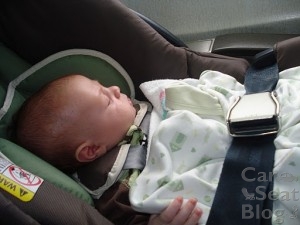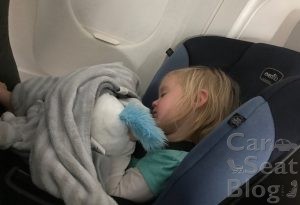Mythbusting: We’re All Going to Die in an Airplane Crash Anyway, So Why Use a Carseat?
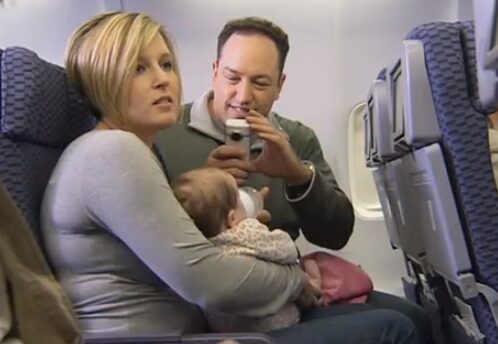
![]()
![]()
![]()
![]()
![]()
It’s not uncommon to see children under age 2 riding on aircraft without child restraints. The Federal Aviation Administration (FAA) doesn’t require airlines to mandate their use, so parents feel there is little risk sitting with their kids on their laps held only by their arms—a federal decision we can equate with state child passenger safety laws that we know meet minimum safety practice, not best safety practice.
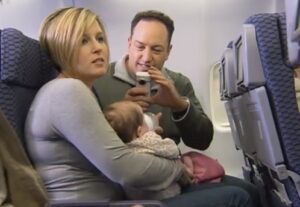
We know that planes are the safer way to travel; therefore, many parents feel comfortable with their decision to hold their children and may have a fatalist “we’re all going to die anyway if the plane goes down” mentality. Let’s examine the argument that “we’re all going to die” in a plane incident and determine if it’s a solid one or not.
Myth: We’re all going to die in a plane crash anyway, so why pay for a ticket just to use a carseat for a child under 2?
Actually, it’s highly unlikely you’ll die in a commercial airplane crash, with statistics through 2018 showing us that there’s 1 fatal accident for every 3 million flights. The last U.S.-owned commercial plane crash in the states was in 2009 and that was a commuter crash in Buffalo, NY, where all 49 people on board the plane died and 1 person on the ground was killed. Before that crash, we have to go back to another commuter crash in 2006 to find passenger fatalities. Certainly when jetliners crash, it’s scary and the story dominates the news for days. Fortunately, deadly crashes are rare, and catastrophic crashes like the Lion Air and Ethiopian Airlines crashes are even more rare and carseats would be useless in those instances. What is more common, however, are runway incidents and turbulence and from those, there are examples of preventable injuries.
Turbulence is the leading cause of injuries to passengers and flight attendants, injuring an average of 58 people every year. It can’t be seen, heard, or smelled. It can sometimes be predicted with weather forecasts, but clear air turbulence (CAT) sneaks up on even the most experienced pilots. This is turbulence found at higher altitudes commonly during winter and is associated with wind shear coming from jet streams, terrain changes, and thunderstorms. The weather may be beautiful, but the plane suddenly drops from CAT.
For example, on February 14, 2019, Delta flight 5763, operated by Compass Airlines from Southern California to Seattle encountered severe turbulence that made it seem more like a roller coaster ride. Five injuries were reported as a beverage cart was tossed to the ceiling in the aisle more than once and a flight attendant was also slammed to the ceiling of the plane. The plane made an emergency landing in Reno to treat those injured.

Here’s video showing the aftermath from passenger Joe Justice, Scrum Inc.:
https://twitter.com/JoeJustice0/status/1095792526609371136. This turbulence was completely unexpected by the passengers.
Just be glad you weren’t on this flight that where the turbulence was so bad, Air New Zealand refunded the ticket price to everyone who took the flight. At least no one was injured.
What about runway incidents? We hear about them on the news when there’s inclement weather and planes have just as much trouble maneuvering on runways as vehicles do on highways. This Southwest flight landed in Burbank, CA, on December 6, 2018, in heavy rain. The rain made the runway slippery causing the jet to slide off the end onto an area of crushable material designed to keep airplanes from crashing onto a nearby street. Did you know about the existence of crushable material to stop planes, called engineered materials arrestor system? Neither did I and that’s another aviation rabbit hole to fall down. Fortunately there were no injuries.
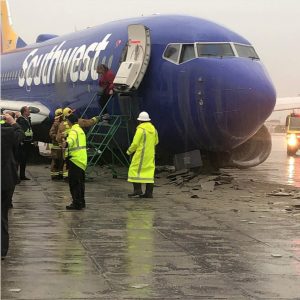
Can you hold your child in unexpected turbulence? Most people overestimate their strength and think they can hold their child in any circumstance, but what about when you’re not expecting to have your seat drop out from under you? If we could hold our children, there would never be any injuries from turbulence.
You may remember this shocking story. In 2014, a flight from Denver, CO, to Billings, MT, encountered severe turbulence and several passengers and a crew member were injured. Among those injured was a 5 month old baby who was ripped from his mother’s arms and flew onto a neighboring adult. One person hit the ceiling so hard it cracked.
Two survivable crashes from which we take away that child restraints on aircraft would have saved lives are the USAir flight 1016 crash in Charlotte, NC, on July 2, 1994, and arguably the most famous crash, United Airlines flight 232 in Sioux City, IA, on July 19, 1989. A former National Transportation Safety Board (NTSB) investigator who worked the USAir crash saw the worst: a dead child being removed from the crash site because her mother couldn’t hold her in her arms during the crash. The NTSB team investigating that crash determined that had the 9 month old been in a child restraint, she most likely would have survived and referenced lessons learned from the United Airlines flight 232 crash.
Following the DC-10 accident in Sioux City, Iowa, on July 19. 1989, the Safety Board issued Safety Recommendation k-90-78 to the FAA to revise 14 CFR Parts 9 I, I2 1, and 135 to require that all occupants be restrained during takeoff, landing, and turbulent conditions and that all infants and small children below the weight of 40 pounds and under the height of 40 inches be restrained in an approved child restraint system appropriate to their height and weight.
The Safety Board believes that if the child had been properly restrained in a child restraint system, she probably would not have sustained fatal injuries.
Jan Lohr Brown, the flight attendant who became an outspoken proponent of child seats on airplanes after surviving the United Airlines flight 252 crash, lives with the guilt of advising Evan Tsao’s mother to place her 22 month old on the floor. As child passenger safety technicians, we give parents an (admittedly basic) equation that helps them understand how much force is required to restrain their children in a crash. Force=weight x speed. If a child weighs 20 lbs. and you’re going 30 mph, it takes 600 lbs. of force to restrain the child. In a plane, speed is much higher and Jan Brown knew that instinctively but airline policy didn’t leave her any other options.
Evan Tsao’s father, Jeffrey Tsao, reflects:
Perhaps the greatest irony of our tragedy is that in nearly every other aspect of Evan’s life, we were so careful. Sylvia and I were zealously safety-conscious and watched over him like hawks. Somehow, though, it never occurred to us that Sylvia should bring an infant-safety carrier on board.
Like most, we didn’t expect our plane to crash; nor did we even realize that plane crashes are often survivable. To us it was just another trip, Sylvia and Evan were on their way to visit her parents in New Jersey while I attended a conference in Michigan. Indeed one part of me desperately wants to blame the airlines for not recommending the use of child-safety seats more widely. If they had, we would certainly have brought a seat on board, and Evan would not have become a loose projectile in the plane. Another part of me suffers, though, knowing that we share in the blame. Evan was always in a child-safety carrier while in our car; how could we have thought he would be safe without one on the plane?
Perhaps the most graphic example of a carseat saving a child’s life on an aircraft was during an aborted takeoff in Florida in 1996. Delta flight 1288 was rolling down the runway when the left engine blew up, sending pieces flying into the cabin. Two adults were killed, but a child was saved from the shrapnel by the high sides of her restraint.
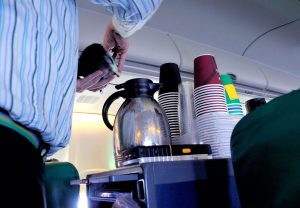 Amazingly burns from hot drinks cause 39% of injuries to children on planes. It’s shocking! And it’s something you don’t think about unless it’s happened to your child. Unrestrained children can bump flight attendants in the course of their duties, causing hot drink spills; and bump laptops and other heavy items making them drop, which cause injuries.
Amazingly burns from hot drinks cause 39% of injuries to children on planes. It’s shocking! And it’s something you don’t think about unless it’s happened to your child. Unrestrained children can bump flight attendants in the course of their duties, causing hot drink spills; and bump laptops and other heavy items making them drop, which cause injuries.
Children under age 2 are the only things on airplanes that aren’t required to be secured during takeoff, landing, and turbulence. You wouldn’t dream of driving with a kid under age 2 unrestrained in a vehicle yet when it comes to cramming 150+ passengers into a thin aluminum tube going over 500 mph, a parent’s arms as a restraint seem just fine? What happens at age 2 that suddenly makes this child worthy of being a paid ticket? Is that the magic age at which parents become attached to their children according to the FAA?

I kept the examples listed above to US carriers (well, except the Air New Zealand flight because—gag—that was awful). There have been many, many more examples of lap children being injured internationally in the past few years, some quite seriously. These are not hard to find.
CONFIRMED, PLAUSIBLE, OR BUSTED?
This myth is Busted since you will most likely NOT die in an airplane crash. There are many more events that can happen on an aircraft that can cause injury and you can keep your child (and yourself) safe by using FAA-approved child restraints.
The problem is that flying is expensive; you’re paying for the privilege of not having to drive hours upon hours to get to your destination. If you’re flying overseas, you don’t have the option of driving. Tickets can cost hundreds or thousands of dollars and it’s tempting to just hold your child since the airlines allow it. Flying is the safest way to travel, yes, but it still has risks and you can mitigate those risks by using restraints both for yourself and for your child. If you don’t want to drag your carseat on board because it’s bulky and heavy, some more inexpensive carseats are actually lighter and easier to take through an airport.
All the major aviation and child safety organizations urge parents to use child restraints on aircraft:
Federal Aviation Administration (FAA)
Did you know that the safest place for your child on an airplane is in a government-approved child safety restraint system (CRS) or device, not on your lap? Your arms aren’t capable of holding your child securely, especially during unexpected turbulence.
NTSB
If you’re flying with children, use an FAA-approved child car seat or safety restraint system. All children, including those under age 2, should be properly restrained in their own seat. Holding an infant in a lap during flight is not a sufficient safety measure.
AAP
Although the FAA allows children under age 2 to be held on an adult’s lap, the AAP recommends that families explore options to ensure that each child has her own seat. If it is not feasible to purchase a ticket for a small child, try to select a flight that is likely to have empty seats where your child could ride buckled in her car safety seat.
Aircraft Owners and Pilots Association
Why should you care for your child less when you fly?
Association of Flight Attendants-CWA
The safest way to secure an infant or child on board an aircraft is in an FAA approved child restraint system (CRS), in a dedicated seat, appropriate for that infant or child. The FAA should make this mandatory and airlines have it within their power to implement this policy today.
International Civil Aviation Organization (a specialized UN agency)
It is not possible for a parent to physically restrain an infant or child, especially during a sudden acceleration or deceleration, unanticipated or severe turbulence, or impact. The use of CRS provides an equivalent level of safety to infants and children as that afforded to adult passengers wearing seat belts.
National Safety Council
The physics of a crash do not allow adults to safely hold children during a crash or severe turbulence, and the FAA even states, “Your arms aren’t capable of holding your child securely, especially during unexpected turbulence.”xv
It is clear that people, no matter what the age, are safest in aviation travel when they occupy their own seat and seat belt, restrained by a mechanism that best fits their size and weight. For children, including those younger than 2 years old, this means an FAA-approved CRD to safely secure the child during turbulence or in case of a crash landing.
There was even a study done on the safety of lap babies. They conducted tests using a 9 mo and an 18 mo ATD while unrestrained (handheld) and while being restrained with a supplementary loop belt (belly belt) attached to the adult ATD’s seat belt. What researchers found is that unrestrained infants may fly through the airplane cabin at speeds of approximately 3-5 m/s or receive skull fractures and life-threatening brain injury if crushed between the adult and seat in front. Infants attached to a seat belt with a supplementary loop belt are at risk of bowel lacerations as well as internal bleeding.

A study was also conducted in Australia of Australian restraints on aircraft which also covered soft front carriers. As you would expect, all of the carriers failed sending the infant dummies flying. Some of the infant dummies were shown to have adult head contact on their lower backs. The study was conducted in 2006 so either these carriers have undergone updates or are gone from the market, but the basic concept applies today: fabric with unreinforced plastic buckles will not hold in crash situations. Here’s a screen shot of FAA testing of a fabric baby carrier:

The biggest question is: knowing that you are a careful parent who would never drive in a vehicle without buckling your young child in their carseat, why would you travel in an airplane without using their carseat? Pilots and flight attendants want you to use a restraint for your child, the NTSB wants you to use a restraint, the FAA suggests you use a restraint, and the AAP does as well. All aviation experts and those concerned with the safety and well-being of children recommend using carseats on aircraft. Child safety seats improve the outcome for those kids harnessed in them in turbulence and other emergencies, then you have a comfortable seat for your child to use and one with which you are familiar installing at your destination and that’s a great way to start off a trip.

